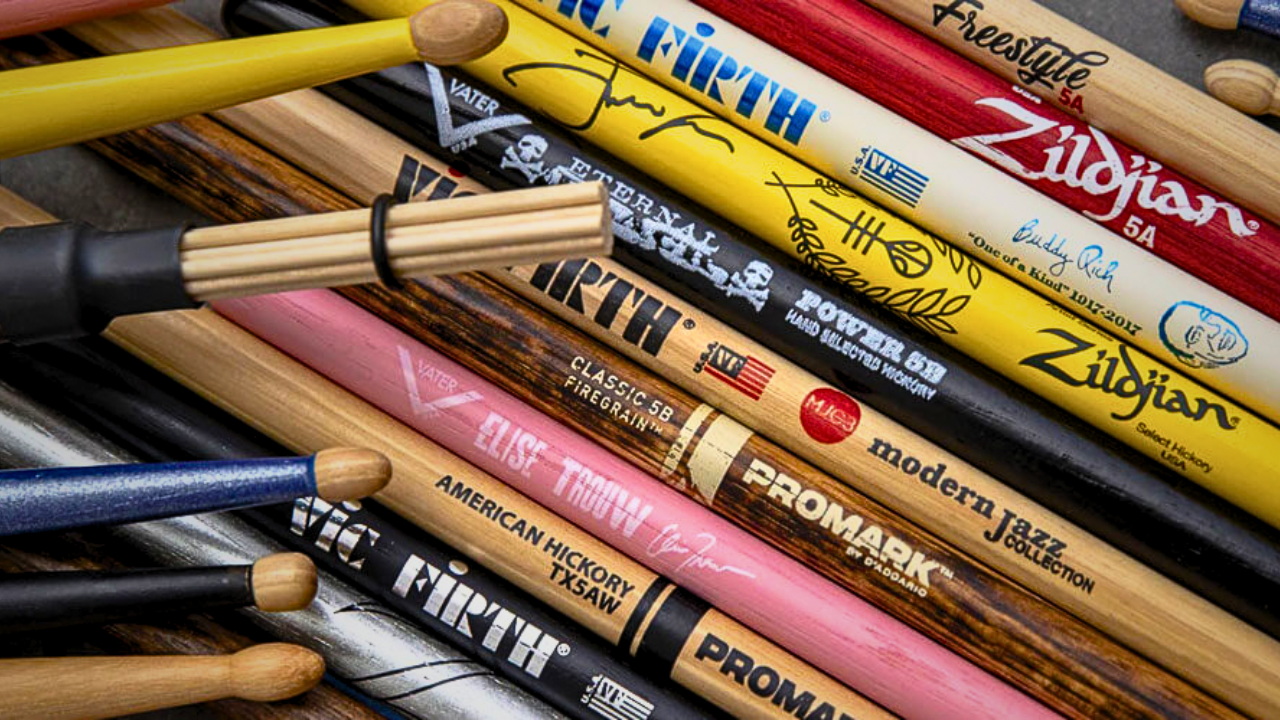As a beginner drummer, you may feel overwhelmed by the thousands of options available on the market when it comes to choosing drumsticks. Do you really need so many of them? In this article, we will explore the basic pairs of sticks that can change your drumming experience.
What Numbers and Letters on the Drumstick Mean
Before delving into the basic sets of sticks, let’s find out what the letters and numbers you see on a drumstick mean. The most common numbers are 7, 5 and 2. These numbers represent the diameter of drumsticks, where the smaller the number, the bigger the stick. So, 7 is the thinnest diameter, 5 is the middle, and 2 is the thickest option.
As for letters, the most common are A and B, indicating the types of music the sticks are suitable for. A-sticks are typically used for orchestral music, while B-sticks are better for loud big band music. Sometimes you may find the letter S, which means that drumsticks are made for marching players. Regardless of manufacturers, the most typical drumsticks that you can see on the market are: 7A, 5A, 5B, and 2B.
Wood
Another important aspect of drumsticks is wood. The most typical wood used for drumsticks is hickory, known for its density and durability. Hickory sticks provide a loud sound when hitting drums and cymbals. Maple sticks provide a lighter feel and result in a brighter sound. Oak is the least commonly used wood, which provides a very hard feel. Today, you can also find drumsticks that feature plastic tips and an aluminium tube core with a polyurethane shaft covering it. These are perfect for rock drumming. Once the polyurethane shaft wears out, you just replace it with a new one.
Drumsticks Every Beginner Drummer Should Have
Now, let’s find out what specific sticks you need as a beginner and how they change your experience as you gradually refine your skills.
5A Maple Sticks
Most drummers aren’t even aware of the existence of such sticks as most standard sticks that the drummers play are made of hickory. Maple provides you with an absolutely different feel during drumming. Compared to hickory drumsticks, maple options weigh less.

As a drummer you want your drumstick to bounce freely with a loose effortless motion, which is not that easy when you’re a beginner. Most of the time beginners use sticks that are too heavy to do that effortlessly. And it's especially a challenge for kids.
Maple drumsticks can really make a difference for beginners, not only kids but also adults. They provide a looser feel, helping you play lightly and quickly and making drumming smooth and more enjoyable. Smaller and lightweight sticks are perfect for learning to play doubles. What’s more, they are also ideal for playing gigs in small rooms as an alternative to brushes as their lightweight construction allows for playing softer and quieter.
Benefits: perfect for light, quick speed, practicing singles, doubles, and soft playing
5A Hickory Sticks
These are standard and all-purpose sticks that can be used for everything. They are naturally heavier than previous options and serve as a perfect balance between lightweight and heavy massive sticks. Hickory sticks work well in settings where you don’t need to play softly or loudly.

As a beginner, you may use maple sticks for starting out with rebound, working on your grip, and training playing doubles. As you progress with that, you can move to heavier hickory sticks, which are perfect for intermediate-level drummers and professionals. They require a bit more effort, incorporating your wrists and fingers.
5A hickory sticks work well in settings where you need strength and power with a firm and consistent backbeat like in rock music. Moreover, when hitting the ride cymbal, a hickory stick provides a more washy sound. Once you learn how to play with 5A sticks, you can move on to any other, heavier sticks.
Benefits: all-purpose sticks, perfect for working on the wrists, warming-up with the drum pad, provide a firm backbeat even when not playing too loud.
5B Hickory Sticks
These sticks have a slightly bigger tip, they are also thicker and heavier than 5A. They are perfect for heavy, compelling, deep groves.

Hickory 5B sticks are challenging for beginners, as they require wrist, finger and forearm strength to drive them. They aren’t the best choice for practicing with doubles and singles right from the start, however they do serve well as working out sticks.
Once you’ve trained your mechanics for playing singles and doubles and enhanced your grip, you can first move to 5A hickory and later to 5B hickory sticks.
Benefits: perfect as working out sticks for drummers with well-trained skills, ideal for loud cymbal crashing and rim shots when you strike the drum head and rim of a drum.
What You Need to Protect Your Drumsticks
Once you have bought a basic set of sticks it’s time to think about how to protect them on the road and in everyday use. Here’s the list of what is helpful:
Drumstick pouch: It’s the best choice if you use just a pair of sticks and need a good balance between reliable storage and quick access to your instruments.
Compact drumstick bag: This is perfect for intermediate-level drummers and students whose collection of gear isn’t limited to just two sticks. A compact drumstick bag offers two pockets for sticks and can be comfortably placed on the tom drum using rubber loops.
Full-size drumstick bag: This option is designed for professional drummers who need more space for all their sticks, including standard sticks, mallets, brushes, and bamboo rods. The full-size bag offers four large compartments for drumsticks and two smaller ones for accessories.
Conclusion
When selecting drumsticks, as a beginner drummer, you should narrow down your choice to the basic number of sticks to train your skills and later incorporate more options into your practice. You may start with a pair of light sticks for soft playing (5A maple), medium-weight sticks that provide a louder sound (5A hickory), and loud heavier sticks (5B hickory) for powerful backbeats and rim shots.
Recently we’ve also shared an article on How to Choose the Best Drumsticks for Your Style. Feel free to check it out.




 https://kgumusic.com/pages/about-us
https://kgumusic.com/pages/about-us